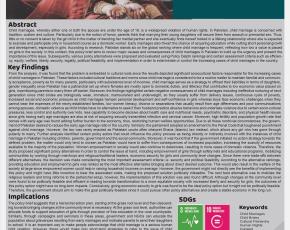Abstract
Child marriages, whereby either one or both the spouse are under the age of 18, is a widespread violation of human rights. In Pakistan, child marriage is concerned with tradition, custom and culture. Particularly due to the notion of honor, parents think that marrying their young daughters will secure them from assault or premarital sex. Thus, little or no consent is taken by the girl child in the matter of deciding her marital partner and she eventually finds herself locked in a lifelong relationship where she is expected to exercise and participate only in household course as a domestic worker. Early marriages also thwart the chance of acquiring education while cutting short personal growth and development, especially in girls. According to research, Pakistan stands six on the global ranking where child marriage is frequent, reflecting how low a value is placed on girls in the society. In this context, this policy brief aims to review major causes and consequences of child marriages in Pakistan to build up the urgency and present the importance of this issue. Subsequently, various policy alternatives were proposed and evaluated using Policy Delphi rankings and certain assessment criteria such as efficiency, equity, welfare, liberty, security, legality, political feasibility, and implementation in order to exterminate or control the increasing cases of child marriages in the country.
Key findings
From the analysis, it was found that the problem is embedded in cultural roots since the results depicted significant sociocultural factors responsible for the increasing cases of child marriages in Pakistan. These factors included cultural traditions and norms since child marriage is considered to be a routine matter to maintain familial and community acceptance, poverty as for many parents, particularly with subsistence level of incomes, child marriage serves as a strategy to offload their liabilities in terms of daughters, gender inequality since Pakistan has a patriarchal set up where females are mostly open to domestic duties, and illiteracy that contributes to low economic value placed on girls, incentivizing parents to marry them off earlier. Moreover, the findings highlighted certain negative consequences of child marriages including ineffective nurturing of next generation since child brides are biologically weak, immature, malnourished and underweight, so they usually suffer from delivery issues, continuous cycle of poverty, increased social and economic pressure as child marriages hamper personal development and self-confidence in girls whereas boys face economic challenges when they cannot bear the expenses of the newly-established families, low women literacy, divorce or separations that usually result from age differences and poor communications among spouses, domestic violence as child brides have no alternative to seek if their husband practice abusive behaviors and undertake violence due to certain socio-cultural pressures, less control and authority over kids, less capability to become decisive about health care and nutritional needs, psychiatric disorders, and physical health issues since girls having early age marriages are also at risk of acquiring sexually transmitted infection and cervical cancer. Moreover, high fertility and population growth rate that comes with early age was found adding further burden to the economy, thus, restricting human welfare opportunities. Due to all these nontrivial circumstances, the government of Pakistan desired to reduce the early age marriage ratio in the country. Similarly, the parliament adopted an amendment to the Penal Code that toughened punishment against child marriage. However, the law was rarely enacted as Pakistani courts often interpret Sharia (Islamic) law instead, which allows any girl who has gone through puberty to marry. Further analysis identified certain policy actors that could influence the policy process as being directly or indirectly involved with the instances of child marriage in Pakistan including children, parents, government and the social community. Moreover, it was found that if the government initiated no action strategy towards the defined problem, the matter would only tend to worsen as Pakistan would have to suffer from consequences of increased population, increasing the scarcity of resources available to the majority of the population. Women empowerment in society would also continue to deteriorate, resulting in more cases of domestic violence. Therefore, the study proposed significant policy alternatives in order to control the issue at hand, including empowerment of girls through safety nets and educational programs, mobilizing communities by working through men/boys and religious/traditional leaders, economic security for girls and community level changes. Since there were trade-offs between different alternatives, the decision was made considering the most important assessment criteria i.e. security and political feasibility. According to the alternative rankings, providing education and employment to girls was ranked as the most effective alternative bringing about direct desired outcome. This would also result in the welfare of the society at large since empowered women could help in raising household incomes on average. However, the government might not directly see the benefits of implementing this policy and might have little incentive to bear the associated costs, making the proposed solution politically infeasible. The next best alternative was to mobilize the religious leaders and bring reforms to the patriarchal setup, however, the implementation of this solution was also found difficult. Although changes at the community level were found to be politically feasible and efficient in leading towards transformation to a more equitable society with increased liberty and security for girls, the outcomes of this policy option might have no long-term impacts. Conclusively, giving economic security to girls was found to be the ideal policy option but it might not be politically feasible. Therefore, the government should aim to make this goal politically feasible since it could pursue other policy alternatives and create a stable economy in the long run.
Implications
The policy brief suggests that a hierarchal action plan, starting at the grass root level and then descending towards bringing changes at the community level is necessary. At the grass root level, authorities can allocate funds to support education of girls through provision of free education in the rural countryside. Similarly, through campaigns and seminars in these areas, government and NGOs can educate the population about grievances resulting from early marriages and motivate parents to send their daughters to school. It is an important way to make people acknowledge that child marriage is a serious human right violation. However, these would make only short-term strategies to cater to the issue of child marriage. To bring about long term reforms and sustained decline in the percentage of early marriages, changes at the macro level are needed. Girls in the economy should have equal opportunities as boys once they complete their education. The government should intervene to generate employment opportunities for girls. Institutions should ensure a positive workplace environment to encourage more girls to enter the labor force. Furthermore, on-the-job training facilities should be introduced to help enhance the skills of female employees. Although laws pertaining to child marriages occur in Pakistan’s Child Marriage Restraint Act (CMRA) and reward strict punishments to the violators, for example, imprisonment up to five years and a fine up to one million rupees, however, these laws are rarely enacted. At various instances, the cases go unreported. Therefore, a third-party source, completely unrelated to the dynamics of rural politics, should chair the authority to report such cases in an unbiased manner. Moreover, parents and community members involved in the practice of forcefully marrying off daughters should be awarded strict punishments. In addition to that, several indicators can help in gauging the progress made in each level to eradicate child marriage such as school enrollment/attendance. This can help gauge the value placed on women empowerment in the society. Women labor force participation rate can also be a good indicator to estimate how many women tend to delay their marriages on average, and the reported cases of child marriage in rural thanas (police stations) can also show the effectiveness of policy implementation if more and more cases start being reported.













